The Cemetery
in Berdichev:
A Crumbling Memorial to a Once-Magnificent Jewish Community
by Yael Shamir-Driver, June 2011
At the end of May, after a long period of debate and hesitation, my father, my husband and myself made it from London to Berdichev. We spent two days and two nights in Berdichev where we divided our time between locating and visiting old Jewish sites and
exploring the only old surviving Jewish cemetery in the town. Below
is a short description of the cemetery and the thoughts it provoked.
The
Current State
Of the three old Jewish cemeteries of Berdichev, only the one housing the gravesite of Rabbi Levy Yitzchak of Berdichev (LIOB 1740-1809) has survived. The other two cemeteries have been transformed into Shavshchenko Park. The LIOB cemetery appears to house graves which date from the middle of the eighteenth century to the late 1990s.
Location
The cemetery, which is public property, is located in
the northern part of the town, on the eastern side of a main road (Lenin
Street) leading out of Berdichev to Zhitomir. The entrance to the cemetery
is from Lenin Street, immediately after passing over a level crossing.
Size
We
believe the cemetery is approximately 250 metres wide and 550 metres
long. These measurements are based on an examination of an eight-year-old
official town map. We further believe that there may be around 10,000
graves in the cemetery. This estimate is based on the overall area
of the cemetery and the fact that some parts of this area may have few
or no graves. [Please note that US Commission Report No. UA05020101,
indicates up to 5,000 stones].
State
The cemetery is overgrown and resembles a wild
wood rather than a cemetery - a very depressing sight (Click on photo
to view full size).
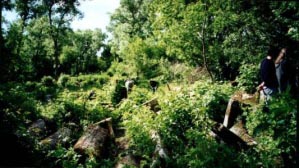
|
|
Photo 1: The cemetery and wild woodland
|
The “centrepiece” of the cemetery is the grave of LIOB,
which is housed in a locked building of brick/concrete. This building
is located approximately in the middle of the cemetery. Unlike the general “wild
wood” state of the cemetery, the immediate area approaching LIOB
burial place [on the left] has been cleared of both trees and undergrowth.
In addition, a strip of approximately 30 metres by 100 metres [leading
from the LIOB’s building towards Lenin Street] has been largely
cleared of trees and larger shrubs. However, lower shrubs and wild weeds
are still in abundance here. (click on photo to view full size.)
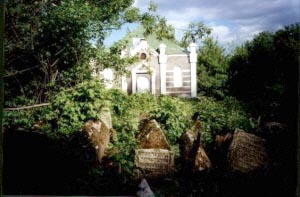
|
|
Photo 2: LIOB
Mausoleum and stones cleared for cleaning
|
Stone Types
The gravestones in the cemetery are of various shapes and
materials. The very old ones are usually made of oblong stone designed
to stand upright. The
writing on these stones is carved rather deeply. The
stones dating from the mid 1880s are generally low long semi
cylindrical shape stones (40 cm off the ground) also with fairly
deep carving. The
third type of stones - dating from 1900 onwards, appears to
be of a granite type material where the carving is very narrow
(almost a scratch) and not very deep. This
makes such stones difficult to read. Many
of these relatively recent stones have a special “boot
like” shape, which appears to be a “local speciality”.
Condition of Stones
Many
of the very old stones and the “sausage” type stones
are covered with moss. However, when the moss is removed, it
is often possible to read the writing (click
on photo to view full size.)
Note that in many cases, surnames are not mentioned (family
names become a regular feature only towards the end of the
nineteenth century). The “boot” type
stones are generally clear of moss but difficult to read.
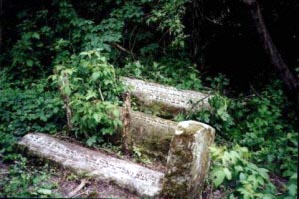
|
|
Photo 3: "Sausage" type
stones after initial cleaning
.
|
Work Done
We cleaned (with hired
help) and then read about 70 stones, about half of which
were situated close to the grave of LIOB (click on photos to view full
size). The majority of these stones relate to persons who died during
the second half of the nineteenth century, although the earliest
stone that we read dates back to 1803. On a number of stones
there is reference to the deceased rabbinical ancestors (Besht,
LIOB, Ish-Horowitz, Rabbi Zeev of Zitomir etc.). Researchers
with interest in the details of these stones are welcome
to contact me [Yael Driver] at drivery@netcomuk.co.uk
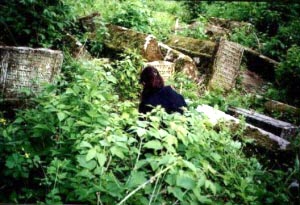
|
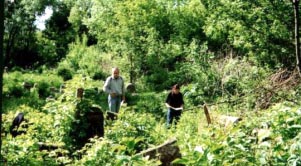
|
Reading
stones in LIOB's cemetery
|
The Rescue Plan
Given
the importance of Berdichev [the “Jerusalem of Vohlin”]
and its central place in the development of Hassidic philosophy and
given that this cemetery is still in a condition which could allow
meaningful restoration, a project is being nursed with the following:
To clear the cemetery of all the shrubbery and undergrowth which hides
many of the stones.
To read, record and publish details of all the stones that can be read.
To reconstruct/reassemble to the extent possible stones which have been broken and/or overturned.
To establish permanent care to ensure that the restored cemetery remains in
an acceptable condition.
With this in mind, and with some funds already pledged, we would be grateful to hear from anybody who can give
help, advice and regarding the following:
Photographic/digital
Environmentally friendly plant control agrochemicals, for use as means
of eradicating the shrubs and other wild growth, without negative effect
on the environment.
Fundraising – names of potential donor both organisations and individuals that would pledge the remaining financial support required for the project.
Volunteers – people prepared to spend time in Berdichev to work ‘on the ground’. We are particularly looking for people experienced in reading traditional Hebrew inscriptions on gravestones.
Read the report
of the U.S. Commission for the Preservation of America's Heritage
Abroad about this cemetery. (link will open in a new window or tab)
Update on Berdichev Cemetery, Sept. 2001: The story continues. Read about progress made.
Mail feedback to: drivery@netcomuk.co.uk